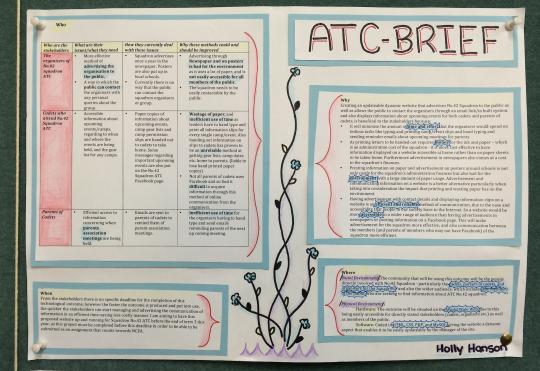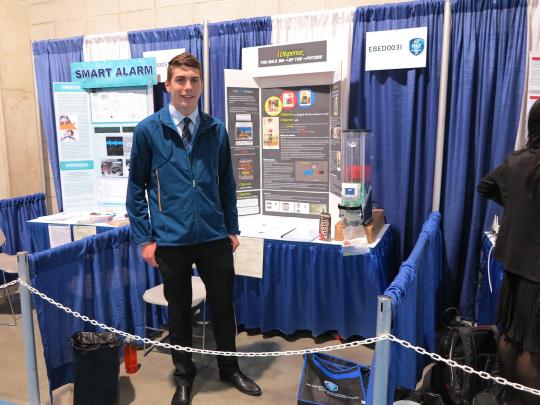Technology Scholarship conversation
Planning and teaching
In the following sections, teachers describe key factors they believe support scholarship success.
Programmes of learning across the curriculum, including all of the strands
Claire and Abby
From year 7, we have a programme of learning that spans all of the curriculum strands and components and we track student progress across levels.
For year 13, we started off by closely examining level 8 of the technology curriculum. We went through the descriptors for level 8 with the students – discussing what they were already doing in their practice, areas that were missing, and steps they could take.
Feedback from the students was regularly sought to ensure their needs were met.
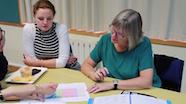
In the following videos, Clare shares about planning, establishing scholarship potential, and growing students’ knowledge in year 8:
Carol
Students have the opportunity to work across the three curriculum strands and are familiar with the language associated with each strand. The senior programme (years 11–13) covers all of the components in each strand. This allows the students to then show their knowledge and understanding within their selected context.
Knowledge of the curriculum and scholarship requirements
Bill
It is important that teachers delve deeply into the level 8 curriculum concepts and are thoroughly familiar with the curriculum and what the scholarship standard is assessing.
In particular, I recommend that teachers examine in-depth the exemplar material and annotations. This material shows what extrapolation, sophisticated integration, abstraction, elegant synthesis, and other scholarship concepts look like in student work. Teachers can use this to help them guide their own students to scholarship.
See NZQA, New Zealand Scholarship Technology.
Claire and Abby
The students developed a shared class glossary of all of the key vocabulary in the curriculum, the standard, and the assessment schedule. Each student was allocated a word. They then had to research their word and share their understanding with their classmates. A shared email was created for this vocabulary list.
Sandy
I think two things are key to students having an in-depth understanding of technology and an ability to perform at scholarship level:
- the learning culture of our department, both at junior and senior levels
- the student progression through the curriculum levels, which we have been building for many years.
Teachers’ learning and building effective student progression are both on-going and evolving.
Authentic projects with authentic issues
Carol
Conversations around contexts and potential issues for curriculum level 8 start in year 12. The students are encouraged to think broadly in terms of the context. Successful scholarship candidates are often those who have moved out of their comfort zone and have had the opportunity to work with the wider community.
We screen the context and issue carefully to ensure that there will be opportunity for the student to demonstrate innovation and elegance in the product and in their own practice.
Sandy
Our scholarship workshops include activities such as:
- looking at the requirements of Scholarship standard
- literacy activities
- scrutinising past students’ work
- discussions around the students’ projects.
Year 13 technology classes begin with at least four weeks of getting the students exploring a “key idea” before they go on to choose the context for their project. This allows an opportunity to challenge ideas and get students thinking about possibilities – many are too quick to jump straight into preconceived outcomes.
This is an ideal point to connect understandings within the nature of technology strand without having to focus directly on assessment – and these understandings assist in providing more complexity around the issue once a context is selected. Those students who continue on to Scholarship are then able to use their understandings to feed into and reflect on their projects.
Students are encouraged to allocate a large amount of time to the brief development stage. This allows opportunity for in-depth exploration around the consumer or key stakeholder, the market, and the technical aspects of their project.
The students need to be given the opportunity to choose their own project direction within a very broad framework and to follow something they are passionate about.
John
Term one is about bouncing around issues for a long time. Our main focus at this time is brief development.
The students do presentations to class, suggestions are made, ideas are rejected in some cases and other paths chosen.They use Google docs to share ideas and seek feedback. I encourage the students to research whether in fact there is already an outcome available for their issue and to think about what their solution will add.
The students notice that successful scholarship students put the time into concept development and then the project takes off and they are way ahead. They also see students who start making far too early and the project fades – as does their access to scholarship.
I find the successful scholarship students take their idea through a number of iterations (and this can happen over years), and then when they do start building, the project has naturally become a lot more elegant, with subtle complexities coming through.
Bill
Students start the year with technical tasks in class and for homework are required to investigate the communities in which they live, play, and sometimes work.
After initial discussions, the students either directly identify their issue or indirectly identify it in terms of its outcome. In the latter case, I refocus the students directly on the issue.
When students select a context and issue it’s important that they are guided in terms of the knowledge base behind it. For example, when designing a learning tool, the students need quality advice about pedagogy. When the expertise students need is not within teachers’ own range of skills and knowledge, they need to seek expertise at the level required for scholarship students.
The teacher also needs to know the student well enough to decide whether the project is a good match for the student and they will be able to deliver.
I tend to avoid competitions as student work done for competitions doesn’t always provide the depth of context that is seen in a genuine and authentic technology need.
It takes an extra level of skill and experience with scholarship to manipulate projects so that they fit the criteria for scholarship and also a competition. Some teachers have had success with CREST projects and we have had good success with Brightsparks. These are science and engineering-focused projects that allow students the opportunity to demonstrate scholarship-level understandings in technology as well as exemplary technical/scientific rigour.
Students need to be reminded that a high level of technical skills with a design and make focus do not meet the technology scholarship criteria.
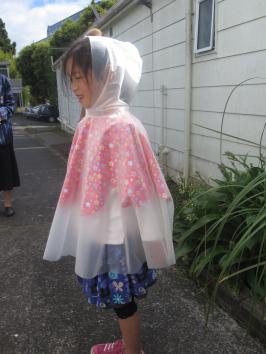 Claire and Abby
Claire and Abby

Five projects that had recent success addressed the following issues:
- The limited choice in the market for teenage boys clothing – menswear is too big and children's wear too small
- Raincoats for schoolgirls – something they will want to wear
- Upcycling – in this instance, glass items into lighting
- Bootin the gluten – the lack of gluten free snack food available commercially
- Snack food for a multi-sport athlete with special dietary requirements where there was not a wide choice currently available.
Each specialist area had given the students a one-word context to begin their thinking. In food and project design, these were more focused – upcycling and snack food. In textiles, the context was very broad – fashion.
In-depth questioning throughout
Sandy
The openness, feedback/feed forward, expectations, and challenges between students and staff are key to scholarship success.
Carol
To me the secret to scholarship success are ongoing open discussions between the teacher and student, ongoing feedback, and challenging questions by the teacher.
Bill
Scholarship students need to demonstrate metacognition. I see this as an awareness of their own learning and I nurture it by introducing the concept of reflection.
Questioning and encouraging students to think more deeply is critical to success in technology and critically essential in scholarship. After the first year or two of teaching, I realised it wasn’t what I knew that mattered, it was about how I could get a student to think about what I was putting in front of them. Questioning is the art of the teacher. Every interaction with the student became a reflective moment for me. What are they asking me? What do they really need? How can I help them on their learning journey at this moment?
Students also need to be encouraged to synthesise – bring ideas together from multiple knowledge bases as they solve their issue.
When students begin to recognise there is more than one right answer, they also become more independent in their practice.
John
There is not a formulaic approach to teaching scholarship that ensures success – rather it requires the teacher to have an in depth understanding of the concepts and to continue developing their knowledge.
The focus of our classes is project-based learning. This means that at the same time as talking about brief development, we can be talking about design and functional modelling and how this will inform their brief.
The project approach is reaffirmed to the students in the way they are asked to collect evidence. We call it their scholarship document, not evidence for particular standards. If it's an authentic technology project, then the evidence for assessment should fall out of it.
I spend a lot of time with the students looking at software engineering, including areas such as the waterfall and agile approaches and design approaches (for example, Dieter Rams’ principles).
Claire and Abby
Teacher questioning is essential in developing students’ critical thinking.
Looking at each other’s projects and looking across different specialist areas is also helpful.
The students can see that they are working towards the same scholarship but applying it to different specialist areas – they are all following a generic technological practice and considering generic understandings in the nature and knowledge of technology. Students have opportunities to critically reflect and extrapolate from the technological experiences of others.
Project management
Carol
The students who can forward plan across their project, organise resources (including finding information, developing questionnaires, speaking with experts in the community), and can then reflect, review, and revise are the students who are demonstrating higher-order thinking.
I emphasise the importance of keeping all evidence – acknowledging a change of plan, or a mistake, and how that has been resolved – rather than providing a sanitised view of practice.
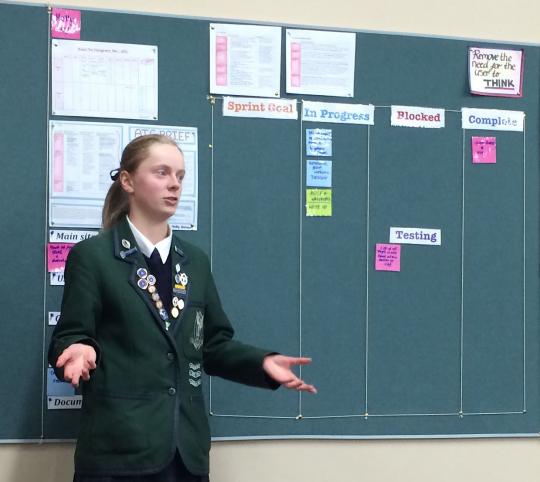
John
I like the students to own and drive their projects from year 11. I find that it’s better if the students understand and own the process rather than have it imposed on them.
I get them to find an issue, research it, find the stakeholders, and discuss the associated problems with both me and the class.
Some students find this quite challenging. Where students are failing, I will step in and start giving them a specified outcome and process. However, if they develop this for themselves at year 11, they are so much better prepared for scholarship – they know that they have developed a successful approach to their technology projects and can continue to refine it. And at tertiary level they will need this independence.
Our classes are made up of mixed ability students. Having high expectations of all students gives everyone access to scholarship. The students in this environment and course structure learn from each other and through their experiences from year to year. For example, they learn from their own experience and watching others' projects that spending significant time on concept development results in mitigating risk and there is a greater likelihood of producing an outcome that is fit for purpose in its broadest sense.
Input from outside experts
Sandy
We encourage students to move outside their comfort zone and interact with a wide range of stakeholders, particularly within the school or wider community. Ideally, outside experts are sought out to assist with specialist and/or technical knowledge to add further dimensions to the project. Guiding students to choose a project that is right for them and putting them in touch with experts often fosters their confidence and independence.
Bill
For students, making one or two deep connections with people about their project can facilitate success in scholarship. It can be the client, a stakeholder, or consultation with an outside expert. Without this real connection, the students’ solutions are too often restricted to “design and make”, even if they are highly competent technically. Having been an engineer, I often pick up on the sort of details that students need to focus on. This doesn’t mean that teachers without experience cannot do it, but they may want to make sure that the student is getting exposure to people with suitable experience, such as Futureintech engineers.
Claire and Abby
The successful students are generally self-regulated and resilient learners who go out and find the expertise they need for their projects. For example, a student working on teenage boys' clothing emailed retailers seeking information. Another student built a great working relationship with a laser-cutter machinist.
Teachers who have a depth of knowledge and expertise in their specialist area can also assist scholarship students. Operating as a faculty allows for a sharing of ideas and individual networks.
John
I bring in a lot of outside speakers from Futureintech and also entrepreneurs. This can prove challenging with three different classes and needing to give all classes equal opportunities.
The specialist areas are diverse within digital technologies these days so choosing relevant speakers can be challenging. I would like to bring in entrepreneurs from other technology specialist areas but the specialisation within digital technologies seems overwhelming on its own.
We also offer students an opportunity in term four to discuss their projects and get feedback from a wider panel of teachers within the technology faculty.
Timetabling
Timetabling arrangements varied between the schools. However, the teachers agreed on the following advice:
- allow for extra time with the scholarship students (there are a variety of ways to organise this)
- start working with scholarship students early in the year
- ensure that students have a good understanding of the expectations of technology scholarship and make a commitment to it.
Claire and Abby
Until a year ago, the school allocated seven periods over seven days for each subject at year 13. The seventh period was intended for scholarship. However, this time was often used for getting through level 3 work. Last year, the school introduced a new timetable structure of six periods over seven days – with every subject having a period zero.
Period zero ran from 7.30am to 8.20am. The technology teachers decided to have one get together per seven-day cycle in period zero for all of the scholarship students. The students were taught as a group with the teachers present. Initially, we started this in term three, but now we start it in term one.
We bring the students together in term one for an introduction to scholarship and to discuss their proposed projects. We check that the students have the complexities in their work from the beginning. The major scholarship teaching starts at the end of term two, and then every period zero in term three.
Carol
We have year 13 students for four 55-minute periods a week. A lot of the groundwork is done in term one, and we have two meetings a term to share information and gain feedback. We encourage the students to complete all level three technology commitments by the end of term three so that term four can be used to focus on the report and supporting documentation. We also plan for individual mentoring throughout the year.
Bill
The students have five periods per week of technology. Generally, they are encouraged to do their practical work in class and spend time on writing their reports out of class time.
At the end of term two and the beginning of term three, I set up a weekly meeting with the scholarship students at 7am.
I set high expectations right from the beginning of the year in terms of their work output. Scholarship students need to be multitasking and making the most of every moment in class. For example, they can be working on seeking feedback, solving a technical problem, updating their brief, and developing software in the same timeframe. Their project management needs to drive the project forward.
I share with students a detailed scholarship year planner. I find that this reminds them of the size of the task ahead and that there is always plenty to do. It’s also a reminder that the school year is short and they do need to work efficiently. The students are expected to monitor their own progress and we use the year planner in our face-to-face discussions.
Coaching students about building resilience to failure and not giving up is key for student success in scholarship. Being an independent learner is essential.
John
Burnside High School offers one line in the timetable that is a project-based course. The class is multi-level – years 11, 12, and 13. Currently, there are three classes running.
Students can opt in at any level. We start the year teaching about scholarship but I carry out multi-level assessment in the class. Students gain credits that reflect the type and level of project outcomes.
We have had a year 11 student who gained scholarship but generally the students achieve at their expected curriculum level. Students who are in these classes for the full three years find that by the time they reach year 13, they do have a clear understanding of level 8 of the curriculum and the associated scholarship requirements.
Using this approach gives students the opportunity to spend more than one year on the same project if they choose to, which allows for multiple iterations.
It also opens the door for a successful year 11 or 12 scholarship student to have a go at outstanding scholarship and top scholar in the following year.
Currently I am teaching all of these classes. However, I would like to see three different teachers involved because we would bring a range of digital expertise to the students and could share this between the classes.
Sandy
At Carmel College, year 13 students are timetabled for nine 50-minute periods over a two-week cycle, and there is no additional time allowance for scholarship classes. Scholarship workshops are held before and/or after school, depending on time availability. This has become more regular and structured this year with the group trying to meet on a weekly basis. Students from Food, Textiles, and Digital Technology areas attended, and all level 3 technology students were welcome at these workshops. This gave the students an opportunity to get an idea of what scholarship involved and to decide whether they felt they had what it took to meet the expectations.

